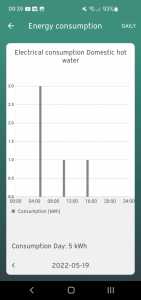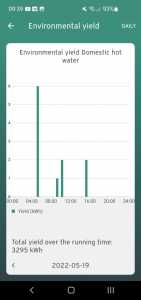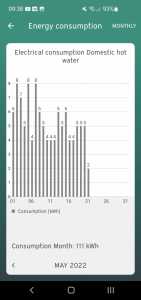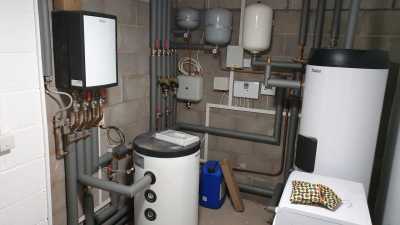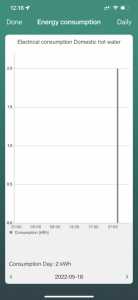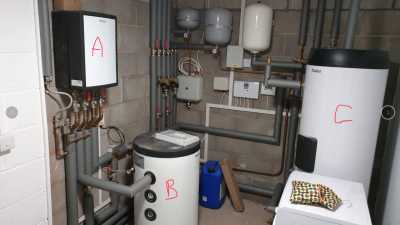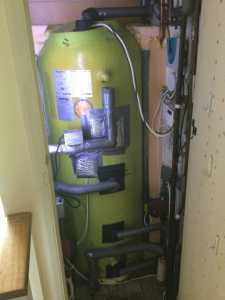I’m an installer of weather compensation control systems for nearly 17yrs. What is important to understand is that it is room temperature that is critical, not radiator temperature.
Right now my living room is 21.5c but radiators 28-30c
Professional installer
Posted by: @webcmgPosted by: @alec-morrow@webcmg why did you want heat in the radiators…the whole point of any heating system is to have warm rooms, NOT hot radiators!
Yes, but if the radiators aren't even warm... Then it's unlikely the room will be warm either. Quick update. Vaillant have been investigating, no real progress, no major changes proposed. Upstairs cold when it's cold outside. Seriously frustrated and disappointed.
Upstairs is cold for one of three reasons:
1. Undersized emitters compared to the ground floor - flow temp designed for downstairs emitters
2. Poor flow to the upstairs due to plumbing issues
3. TRV/Balancing issues with the upstairs circuit
Off grid on the isle of purbeck
2.4kW solar, 15kWh Seplos Mason, Outback power systems 3kW inverter/charger, solid fuel heating with air/air for shoulder months, 10 acres of heathland/woods.
My wife’s house: 1946 3 bed end of terrace in Somerset, ASHP with rads + UFH, triple glazed, retrofit IWI in troublesome rooms, small rear extension.
Vaillant have made some recommendations on changes to the system, I'm not convinced they'll address the issue and it will be difficult to know until the winter now.
On a separate note, how many kwh of electricity might be typical to just heat the hot water at this time of year? I think we have a 250l or 300l tank.
We seem to be using between 4 and 9 kwh per day currently just for the hot water. Is that about right or comparable to your setups?
Heatpumps will give a poor COP heating dhw - they have to run hot which they don't like, and there's often a lot of pipework that gets heated unnecessarily. You could try fitting an energy monitor onto your immersion and heating with that for a week to find the in-use COP of the heatpump. Even this isn't "perfect", as in both cases the tank itself looses heat. The tank standing losses could be found by leaving it on this monitored immersion while everybody is away for a few days. You can reduce the standing loss by adding extra insulation around the tank - box it in, pour in EPS beads (don't insulate elec stuff).
Heat on demand elec showers - they're not usually as powerful so people don't like them, but they do avoid all of the standing loss, and may even be more more "efficient" than heatpump+tank. You can even get heat recycling or water+heat recycling showers! All DHW generally produces relatively concentrated heat down the drain, so there is a lot that could be done to reduce energy use.
Here's an interesting "endless" recycling shower, I think intended for camping - it uses 6l of water, and just 24W!
google "loopz shower", or "recycling shower" - I don't think it liked me linking to it direct.
Posted by: @colin@webcmg We're averaging 2kwh consumed per day with DHW set to 46°C and a 300L Vaillant tank, which lasts 2 adults & 2 small kids all day no problem.
Thnks, I would be interested to know what settings you use. Assume it isn't on 'constant' and that it is set for a significant drop off in temp before reheating?
You can see my usage and yield for DHW in the images below. There is typically a large spike at 4am...
Daily view
Monthly view
Posted by: @roblHeatpumps will give a poor COP heating dhw - they have to run hot which they don't like, and there's often a lot of pipework that gets heated unnecessarily. You could try fitting an energy monitor onto your immersion and heating with that for a week to find the in-use COP of the heatpump. Even this isn't "perfect", as in both cases the tank itself looses heat. The tank standing losses could be found by leaving it on this monitored immersion while everybody is away for a few days. You can reduce the standing loss by adding extra insulation around the tank - box it in, pour in EPS beads (don't insulate elec stuff).
Heat on demand elec showers - they're not usually as powerful so people don't like them, but they do avoid all of the standing loss, and may even be more more "efficient" than heatpump+tank. You can even get heat recycling or water+heat recycling showers! All DHW generally produces relatively concentrated heat down the drain, so there is a lot that could be done to reduce energy use.
Here's an interesting "endless" recycling shower, I think intended for camping - it uses 6l of water, and just 24W!
google "loopz shower", or "recycling shower" - I don't think it liked me linking to it direct.
Thanks, we're in a new build so not planning on replacing showers just yet. How would you approach better insulating this setup? Is the fact the DHW tank and buffer are directly on the garage floor without insulation potentially problematic?
@webcmg We're on Octopus Go Faster so we have the DHW set to come on during part of the cheapest period when it's 5.5p per kwh so essentially we 'charge' up the cylinder during the cheapest period which costs approx 11 pence daily. We run an Anti-legionella cycle on Friday nights which consumes about 5 units which costs about 27.5 pence. All in all, it totals less than a quid a week, with a bit of tweaking/testing I'm sure you could achieve similar figures.
@webcmg There is a lot of stuff there, it’s a neat job. Have I understood correctly:
A is a heatexchanger box, likely glycol:water, probably has a diverter valve in it too.
B is a buffer tank for the heating circuit
C is a pressurised hot water tank
Everything is in an uninsulated garage? Could you insulate the garage (ewi), I expect it would be warm then!
I would use a thermal camera to find hotspots - I’d expect pipes under A to be hot when the ashp is on. I’d run the dhw for a few days while away/not using, to find standing losses - then you can decide how important that 1..2..3kWh/day elec waste is compared to other things. One big 400W south facing PV panel on average would give around 1kWh/day, admittedly skewed to summer, as a reference.
For comparison, our dhw tank is a 216l open vent copper one but with twin coils for solar thermal(ST, lower left) and conventional heating(top and left). It’s in our house in the original ‘airing cupboard’, with a few XPS pieces around it and poly beads poured behind. Not as neat, but hidden and works well, any losses being to house. Doing that also has the advantage that you can’t lose socks down the back anymore! Nb: even with all that insulation, the socks dry fast there as the pump and controls that shouldn’t be insulated lose plenty of heat. Nb: I wouldn’t get ST now, PV is now so cheap, it’s lower maintenance, and more useful.
@robl thanks for the reply. Your assessment of A, B, C is spot on. The garage isn't completely uninsulated but the loft space insulation can definitely be improved. We're working with the developer to identify and implement modifications to the house (snagging) and heating system (due to the poor performance in relation to comfort and efficiency) so don't just want to get it sorted myself and interfere with the process. For example, we know that we have some drafty windows and I have identified some other issues with the insulation in the main house.
Once that's been completed, I will be looking to make whatever improvements necessary to further improve efficiency because I'm concerned we have such a high kwh usage for heating in the winter. If unit prices go up after our fixed rate tariff we could be spending £750 per month in the winter to heat the house.
We have a very large south-facing roof, so would consider PV and batteries etc. However, I'm new to all this though so need to do some research to assess how this would work and how much it would cost.
The pipes under A do get very hot, could they be insulated, I assume not because they are controls?
I think it is fine to insulate controls, just you can't get to them so easily. It's electrical stuff that shouldn't be, as it is a heat source in it's own right and may overheat (electric valves, the head of an immersion). Assuming that it all gets hot and is in a garage, I would insulate all of the stuff under A and the flexi pipe etc (assuming it gets hot) near it.
You could put IWI on the wall behind, and build up a box out of some sort of foam insulation , XPS is the easiest to use I find, doesn't mind water, good to 90C or so. Make the front of this box be removeable, so the controls can be got at if need be - I expect this is for swapping out the heat exchanger, or perhaps during a service.
Alternatively you can add more pipe insulation to what's there, covering everything you can. You can get neoprene flexible insulation to cover the flexi pipe too, and even insulation "jackets" for (manual) valves too. You could bubble wrap around those and other manual valves, in a way that's easily removeable.
The pipe insulation that is there looks good, there are just lots of uninsulated bits, and there is a lot of pipework in a garage! Pipe insulation isn't magic, it's only thin with a big temp drop across it.
Re-reading what you actually said though (!) it sounds like you want to assess rather than do. Many organisations offer free loan of a thermal camera these days (Camb Carbon footprint, where I am, I am sure there are many others). Or the (unused) dhw losses/day test I suggested. Whatever the loss is, it will increase in winter as it gets colder.
PV is a great thing these days of high energy costs! My advice is try and get as much as possible - 16A export is always allowed(often described as 4kWp), your dno may allow more. PV+battery costs 2x, but it allows more PV, and allows better utilisation by you of the PV. From scratch, I would go PV(max you can fit)+batt. If that was too expensive, PV(max fit/afford)+hybrid inverter(limit to 16A out if dno insists) - then when funds permit get a batt.
-
Weather compensation- why you should use it
21 hours ago
-
Rodents! A word of warning for heat pump owners
1 day ago
-
Where has Watson gone?
1 day ago
-
First time wall mounting an ASHP
2 months ago
-
How can I programme a setback for my Samsung Gen6 8kW heat pump?
2 months ago
Currently viewing this topic 1 guest.
- 26 Forums
- 2,396 Topics
- 54.3 K Posts
- 369 Online
- 6,077 Members
Join Us!
Worth Watching
Latest Posts
-
RE: Recommended home battery inverters + regulatory matters - help requested
@jamespa you can route the off Grid port to a switch w...
By Judith , 2 minutes ago
-

RE: Free Ecoheat Heat Pump Install
@deltona Yes older houses are problematic like that, bu...
By bontwoody , 57 minutes ago
-
RE: Radiator sizing sanity check
As I mentioned early on the cost of supplying and fitti...
By JamesPa , 4 hours ago
-
RE: Advice for a novice on Mitsubishi Ecodan 6kW
I hadn't spotted that there were two pumps in the UFH (...
By JamesPa , 5 hours ago
-
RE: Setback savings - fact or fiction?
Never assume it makes an ass of u and me! You need the...
By JamesPa , 5 hours ago
-
RE: New Mitsubishi Ecodan 11.2kW installation - L9 errors and maybe more
Before I answer your specific questions just one more t...
By JamesPa , 6 hours ago
-
RE: Help me keep the faith with my air source heat pump installation
@agentgeorge Fortunately the one thing that you *won't*...
By dr_dongle , 6 hours ago
-
RE: ASHP Energy Consumption: Aira 12kW heat pump
@chandykris Thank you for your detailed response.It is ...
By Wally , 7 hours ago
-
RE: Electricity price predictions
Great point, one of the key ones in my chat with Octopu...
By Batpred , 16 hours ago
-
RE: Running from backup generaor in powercut?
Definitely and professionals sometimes miss it. I had...
By Batpred , 16 hours ago
-

RE: New Fogstar 15.5kWh upright solution
Let me point out that there are many Chinese suppliers ...
By Transparent , 21 hours ago
-

RE: Weather compensation- why you should use it
@majordennisbloodnok — The Two Ronnies Mastermind sketc...
By cathodeRay , 21 hours ago
-
Just realised that this image of the cylinder cupboard ...
By Sheriff Fatman , 1 day ago
-

RE: Rodents! A word of warning for heat pump owners
Two thoughts: 1: Let's ask @david-s if Primary Pro in...
By Transparent , 1 day ago
-
RE: Solis S6-EH1P8K-L-PLUS – Why I Chose It and What I’ve Learned So Far
In the diagram below, I describe my understanding of th...
By Batpred , 1 day ago
-
I need to have a look out for it. I know IBM feeds some...
By Batpred , 1 day ago
-
-
RE: Daikin Atherma ASHP Cycling 6 Times an Hour?
Thanks for your reply. Yes that's a good idea to try a...
By John Marshall , 1 day ago
-

RE: Hot water heating in parallel with space heating
An external heat exchanger would need a pump which woul...
By bontwoody , 1 day ago
-
RE: Gen 6 Samsung ASHP losing 20C of DHW in 60 min directly after generation
@ecobaker Thanks for this. I've had it in both slots. ...
By andbeck , 2 days ago


